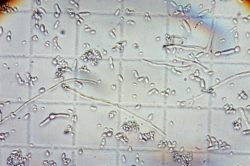Theories on fairy circles
Fairy circles appear in South Africa's most arid regions, and have recently been discovered in Australian deserts. These "dead zones" can be from two to forty meters in diameter; what's more, they migrate periodically every several tens of years. There are many hypotheses on their nature.
A couple of years ago, the idea that they have to do with termites was really popular: the insects eat up seeds and roots, and after nothing is left, the colony dies and plants start to grow again. Yet, researchers can't explain why termites prefer living in these circular areas and do not expand their territory after resources end.
The other version has to do with plants struggling for survival. Water accumulates in tunnels made by the insects, and plants try to grow as close to them as possible. This would explain their abundance on the edge of termite colonies.
 Fairy circles Credit: joyreactor.cc
Fairy circles Credit: joyreactor.cc
There's also a theory that links fairy circles to plant's self-regulation — rainfalls flow along clearings towards certain places, stimulating plant growth. Yet, this does not explain why these clearings are circular and why water doesn't spread evenly over the surface. There were also assumptions that these circles are a result of radiation brought by meteor showers or effects of gases that leak from underneath the earth.
Microorganisms are to blame
The team from the All-Russian Research Institute for Agricultural Microbiology works on a theory that fairy circles are an effect of microorganisms. The scientists noticed that these circles appear where once euphorbia grew. After the plant dies out, the soil becomes unfit for plant life.
"For instance, there are black truffles that grow in France. On the soil above them, plant life is weaker; grass does grow, but it's lower than usual. It turned out that truffles contain particular protein sequences that are responsible for suppression of plant life. Hence, we can research this protein sequences and their effect on plant growth," explains Sergei Mishin, Master's Degree student from ITMO's Department of Food Biotechnology (Vegetable Stock).
 ITMO University. Team of the All-Russian Research Institute for Agricultural Microbiology. Andrei Sherbakov (on the far left) and Sergei Mishin (on the right).
ITMO University. Team of the All-Russian Research Institute for Agricultural Microbiology. Andrei Sherbakov (on the far left) and Sergei Mishin (on the right).
Fairy circles might appear due to similar reasons. It has been proved that symbiotic microorganisms reside on euphorbia's roots. The microorganisms release special hormones for the plant, and the plant feeds them with sugar or acids. As result of this symbiosis, there can also be by-products — protein sequences, for instance. And this is what's responsible for plants dying off. Outside the circle's territory, euphoria grows without help from microorganisms, which means that there are no by-products that can affect the soil.
Scientists from the laboratory of Technical Microbiology now work with soil samples from Namibia's deserts. They've succeeded in subtracting pure cultures of microorganisms that can be identified using molecular-genetic methods and researched for particular properties, and have already conducted experiments on their effect on plant growth — for instance, the growth of garden cress. According to Sergei Mishin, they've used this particular plant, as it is susceptible to microorganisms and grows really fast. If it will turn out that microorganisms from Africa kill it, then the new bio-herbicide will be tested on weeds as well. As of now, the research is still on the stage when laboratory experiments are conducted. Soon, ITMO's Master's students will start experiments in a greenhouse complex.
What is the point of researching fairy circles.
The laboratory's research focuses on creating new means to increasing efficiency and biologization of agriculture. By researching microorganisms from fairy circles, scientists hope to create a new herbicide that will help eliminate weeds. If it turns out that these microorganisms suppress the growth of weeds, they will become a great alternative to chemical herbicides that are currently used in agriculture.

For example, several years ago the ground layer of forests in Netherlands became filled with prunus serotina, a shrub that disrupted the ecologic balance. Scientists launched a research for solving the problem and found a particular mushroom — Chondrostereum purpureum — that killed the plant. By using it, more than 90% of forests in Netherlands were cleared of the shrubs.
"This process is natural — only that in nature, it usually goes a lot slower. The scientists' task was to control the process. This approach to eliminating weeds proved to be a lot safer than using chemical herbicides, as no chemicals get into soil and ground waters. What is more, producing herbicides is cheaper, so they cost less. Yet, this doesn't mean that we should completely stop using chemical herbicides — it’s just that they stop working at some point," comments Andrei Sherbakov, head of the project on researching euphorbia.
Point is, weeds mutate and become resistant to chemicals. This is similar to what happens to antibiotics, when bacteria adapt to the effect of medication. What's more, new plant diseases induced by phytopathogenic organisms often appear — all of that contributes to the necessity to use more and more herbicides and fungicides, which leads to weeds becoming even more resistant.
Bioherbicides can be the solution here. They synthesize particular agents that change a plant's vital functions. As a result, this leads to its death.

What are the difficulties of using bioherbicides.
Plants can develop immunity to bioherbicides, as well. Yet, scientists have means to prevent it. First of all, the herbicide's acting agent has to remain unchanged, i.e. not mutate. To achieve that, scientists freeze it by cryopreservation. Secondly, bioherbicides are constantly "trained" on weeds by infecting them. If some don't work, they are excluded from research.
Another problem is that some herbicides can eliminate crops as well. This can be solved by vaccination — same as it’s done with humans. What's more, in certain cases the bioherbicide's aggressiveness can be beneficial, like when one has to completely eliminate all plant life on a certain area. A good example of that is clearing utility areas like take-off strips in airports, explains Andrei Sherbakov.

"We are working on special herbicides that affect only particular plants. For instance, in the Leningrad region there's the giant hogweed problem. Another persistent weed is richweed," comments the specialist.
Research on effective bioherbicides is conducted by many countries. Yet, in Russia there are only a few groups that work in this line of research, even though the demand for high-quality and ecologically clean products constantly grows. Thus, bioherbicides can well become the next step in protecting crops in modern agriculture.





